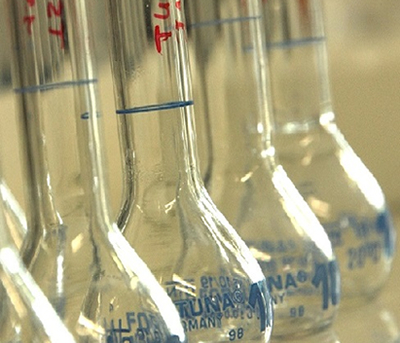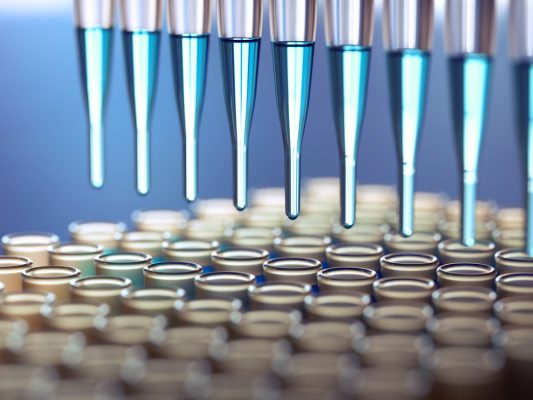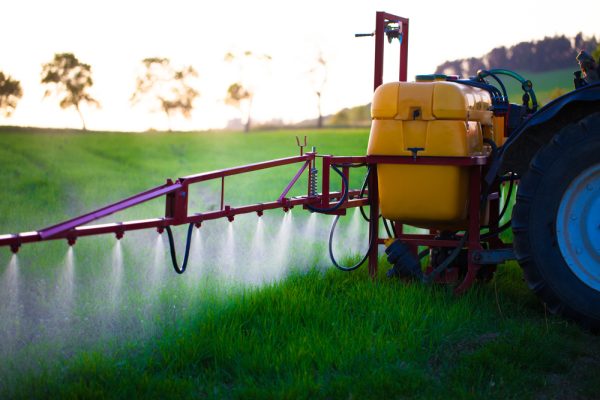Chemical-Physical properties
Chemical and physical data are required to support the approval of an active substance and the authorisation of a formulated product.
For Plant Protection Products (PPPs), Biocides and Veterinary Medicinal products (VMPs) the chemical, physical and technical characteristics, along with their shelf-life, are intended to show the safe and effective application of these products, according to their directions of use and that, during the storage, the formulation preserves the active substance and physical-chemical characteristics.

BioTecnologie BT staff is familiar with many types of formulations:
CS, DP, DT, EC, EW, FS, GR, GW, ME, OD, SC, SE, SG, SL, SP, ST, WG, WP, WT and ZC
Storage Stability Studies
Cold Stability Testing (0°C) according to CIPAC MT 39.3
Accelerated Storage Stability according to CIPAC MT 46.3
Shelf Life at Room Temperature
Analytical profile of batches of technical materials and formulated products
The analyses of at least five representative batches of production on an industrial scale recent and current of the active substance, is necessary to determine the content of the pure active substance, impurities, additives, and any other additional component. Data reported must include the results of the analysis of individual samples and a summary of these data, showing at least the minimum, maximum and average of each significant component.
Microbial Pest Control Agents (MPCA)
The analyses of at least 5 representative batches of production, or pilote-scale batches, is necessary to determine the content of the pure active substance, microbial contaminants and pathogens.The manufacturing processes have the potential of producing unwanted micro-organisms in addition to the desired MPCA which include pathogens, their associated toxins and other metabolic by-products of health concern.
Our unit studies and tests:
Analytical Method Validation for determination of the active ingredient and impurities
Impurities: any component other than the pure active substance which is present in the active substance as manufactured (including non-active isomers) originating from the manufacturing process or from degradation during storage.
Relevant impurities: impurities of toxicological and/or ecotoxicological or environmental concern which are known, or can be expected, to occur in the active substance as manufactured. For preparations, impurities are defined as relevant, if the composition of the preparation is such that, on the basis of theoretical consideration, impurities of toxicological and/or ecotoxicological or environmental concern may be formed by the manufacturing process of the preparation or from degradation during storage.

STUDY DESIGN
Method validation, to determine the substance/s and relevant impurities content in formulated products and in technical materials, are performed according to SANCO/3030/99 rev. 4 guidance document.
Validation of the analytical method includes:
Linearity with at least 5 concentrations of the analytical standard or 3 concentrations of the analytical standard in the appropriate range of concentrations (R2 > 0.98).
Precision with 5 sample solutions resulting from 5 independent weighings (RSD % < RSD % calculated by modified Horwitz equation).
Accuracy with at least 2 fortification levels on blank formulation and at least 1 blank sample for the interference check and specificity with the possible use of the standard addition method (range for mean recovery according to active substance/impurity nominal content and interferences < 3% of total peak area of the target analyte).
Confirmatory analyses/specificity by high specific technique or other proper confirmatory technique.
LOQ determination (only for relevant impurities) as the lowest concentration tested, at which an acceptable mean (LOQ) recovery with an acceptable RSD, is obtained.
Study includes GLP managment and reporting.
REFERENCES AND GUIDELINES
SANCO/3030/99 rev. 4 (11/07/2000) – Technical Material and Preparations: Guidance for generating and reporting methods of analysis in support of pre- and post-registration data requirements for Annex II (part A, Section 4) and Annex III (part A, Section 5) of Directive 91/414.
Determination of the Partition Coefficient n-octanol/water
The partition coefficient (Pow) is defined as the ratio of the equilibrium concentrations of a dissolved substance in a two-phase system consisting of 2 largely immiscible solvents (n-octanol and water). Being Pow the quotient of 2 concentrations, or the quotient of the fractions of the test substance in the 2 phases multiplied by a fixed volume ratio, is dimensionless and is usually given in the form of its logarithm to base ten.
OECD TG 107: Determination of the partition coefficient n-octanol/water: Shake flasks method (Solubility > 10-2 g/L)
OECD TG 107: Determination of the partition coefficient n-octanol/water: Shake flasks method (Solubility > 10-2 g/L)
Test vessels containing the two-phase system are placed in a mechanical shaker. After a set mixing time, phase separation is carried out usually by centrifugation. The test substance concentrations are determined in both phases and the total quantity of test substance present is calculated and compared to the amount initially added.
STUDY DESIGN
Method validations, to determine the substance content in water phase and in n-octanol phase respectively, are performed according to SANCO/3030/99 rev. 4 guidance document.
Validation of the analytical methods for each phase includes:
Linearity with at least 5 concentrations of the ananlytical standard (2 injections/concentration) in the appropriate range of concentrations.
Precision with 5 sample solutions (2 injections/sample solution)
Accuracy with al least 3 fortification levels with 3 samples for each fortification level (2 injections/sample solution) and 1 blank sample for the interference check and specificity.
Confirmatory analyses/specificity by high specific technique or other proper confirmatory technique.
LOQ and LOD determinations.
The test for the determination of Pow is carried out in temperature range (25±1)°C. 2 sample solutions for each volume ratio of the 2 phases are performed except for the 5 sample solutions related to the precision check.
For ionizable substances, the test will be planned to take into account the effects of pH.

REFERENCES AND GUIDELINES
OECD Guideline for Testing of Chemicals, No. 107 (27th July 1995) – Partition Coefficient (n-octanol/water): Shake Flask Method.
SANCO/3030/99 rev. 4 (11/07/2000) – Technical Material and Preparations: Guidance for generating and reporting methods of analysis in support of pre- and post-registration data requirements for Annex II (part A, Section 4) and Annex III (part A, Section 5) of Directive 91/414.
Physical Compatibility with other products
ASTM E1518-05 Physical compatibility with other products
The method is aimed to evaluate the physical compatibility and stability of pesticide tank mixtures diluted for aqueous application and it can be also adapted to use with liquid fertlizers. Compatibility is measured in terms of dispersion stability and wet sieve residues. Formulation is added into a wide-mouth jar containing 100 mL of synthetic hard water, the jar is swirled to ensure a good dispersion. A specific amount of the additional pesticide is added into the jar which is capped and swirled. After an appropriate shaking time, the jar content is poured through a 50-mesh sieve. 50 mL of synthetic hard water are transferred into jar and poured through a 50-mesh sieve for 2 times and the residue remaining both on the jar and 50-mesh sieve are observed.

STUDY DESIGN
On case by case basis, the following experimental conditions are set: number of application doses of test formulation, number of pesticides to be mixed with the test formulation and number of binary mixing and individual (as controls) samples to be evaluated.
The results are expressed, in terms of evaluation of dispersion stability and residue %, according to the following definitions:
Compatible Formulation:
Mixture of pesticides in water is well-dispersed and no nonrinsable residue are found on the 50-mesh sieve or remaining on jar walls.
Incompatible Formulation:
There is a separation of the mixture of pesticides in water and/or presence of flocculation, coagulation, gel or curd during or at the end of the test that not re-disperse nor pass through the 50-mesh sieve or remaining on the jar.
Study includes GLP management and reporting.
REFERENCES AND GUIDELINES
ASTM E1518-05 – Standard practice for evaluation of physical compatibility of pesticides in aqueous tank mixtures by dynamic shaker method.
Range of tests performed

pH CIPAC MT 75.3
Acidity/Alkalinity CIPAC MT 191
Viscosity OECD TG 114-CIPAC MT 192
Surface tension OECD TG 115-EC A.5
Relative density OECD TG 109-ISO 758-EC A.3
Bulk density CIPAC MT 186
Dissociation costant in water OECD TG 112
Water solubility OECD TG 105-EC A.6
Solubility in organic solvents CIPAC MT 181
Persistent foaming CIPAC MT 47.2-MT 47.3
Suspensibility CIPAC MT 184
Spontaneity of dispersion CIPAC MT 160-MT 174
Pourability CIPAC MT148/148.1
Dissolution degree and solution stability CIPAC MT 179.1
Dilution stability of aqueous solutions CIPAC MT 41-MT 41.1
Dispersion stability CIPAC MT 180
Wet sieve test CIPAC MT 185
Dry sieve test CIPAC MT 170
Particle size distribution OECD TG 110-CIPAC MT 187
Emulsion stability, emulsifiability, re-emulsification CIPAC MT 36.3
Wettability CIPAC MT 53.3
Dustability CIPAC MT 34
Dust content CIPAC MT 171.1
Flowability CIPAC MT 172.1
Dissociation rate of water soluble bag CIPAC MT 176
Solution properties of ST formulations CIPAC MT196
Attrition-Hardness and Integrity CIPAC MT 193
Attrition resistance of granules CIPAC MT 178.2
Disintegration time (Internal method)
Adhesion to treated seeds CIPAC MT 194
Seed loading (Internal method)
Uniformity of distribution on seeds CIPAC MT 175
Flashpoint EC A.9
Pyrophoric properties for solids and liquids EC A.13
Flammability (solids) EC A.10
Flammability (gases) EC A.11
Flammability on contact with water EC A.12
Explosive properties EC A.14
Auto-ignition temperature (liquids and gases) EC A.15
Realtive self-ignition temperature for solids EC A.16
Oxidising properties (solids) EC A.17
Oxidising properties (liquids) EC A.21
Study finder
Scientific Contact
Anna Paola Fifi
E-mail: apfifi@biotecnologiebt.it
Phone: +39 075 895 0045 – Ext. 245
Stefano Paronuzzi
E-mail: sparonuzzi@biotecnologiebt.it
Phone: +39 0371 4662700
Business Contact
Katy Lazzari
E-mail: klazzari@biotecnologiebt.it
Phone: +39 075 895 0045 – Ext. 246
Discover the other Expertise
Didn’t find what you are looking for? Send us a message!
Fill in the form with the required information (*).
Our team will be happy to provide all the necessary support with regard to your request.


 English
English Italian
Italian